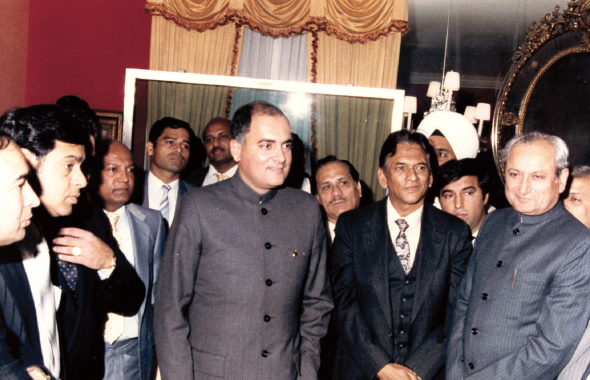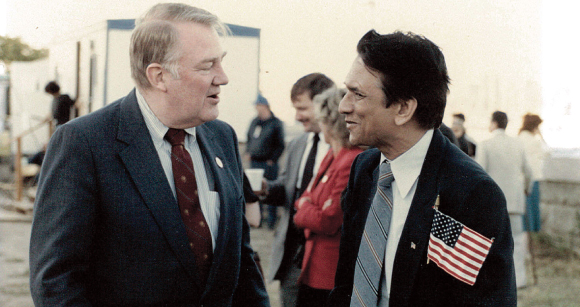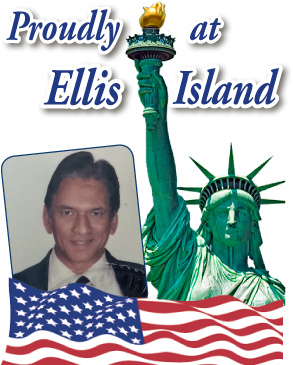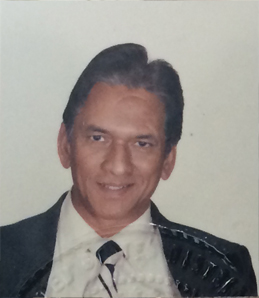In those Moments He Still Treasures, a Driven Engineer Became Part of American History at Ellis Island
By Jawahar Malhotra
SUGAR LAND: It was a clear, sunny July 3rd day in 1986 with just a slight sea breeze along the shoreline of the New York City harbor, just the perfect weather for the rededication of Lady Liberty whose statue had graced the Western entrance to the New World for a hundred years as generations of new immigrants streamed into their new homeland.

Ram Gupta, to the left of the late Indian Prime Minister Rajiv Gandhi during his trip to the US in 1987.
The passage of time and the salty sea spray had taken a toll on the copper skin of the statue and two years earlier it had been closed down so that work could begin on restoring the icon of liberty to the original condition when French sculptor Frederic Auguste Bartholdi and structural engineer Alexandre Gustave Eiffel (designer of the Eiffel Tower) had designed and built it. Appeals were made for private donations to supplement federal funds for the restoration of the Statue of Liberty and the adjoining Ellis Island. With former Chrysler Chairman Lee Iacocca appointed by President Ronald Reagan to spearhead the $87 million effort, the work was completed within two years.

Ram Gupta speaks with US Attorney General Edwin Meese after the swearing in ceremony at Ellis Island on July 3, 1986
During the same two years, a hardworking, dedicated structural engineer from Rampur, in the northern state of Uttar Pradesh, India was directing his career forward by designing and building large scale nuclear power plants for world-class firms like Brown and Root, Bechtel and Ebasco. His attention to detail and the strength of his vast experience had already earned him a solid reputation in his field.
But in his quest to make a mark for himself as a respected engineer and an entrepreneur, one detail had eluded Ram Avtar Gupta as he built a life for himself and his growing family in their new home in America. He was living in Houston and had submitted his application for naturalization in 1984, but for some reason it was rejected. Not one for being demure or taking such a thing lying down, Gupta took the matter straight to the top by writing, in 1985, to Senator Lloyd Bentsen who represented his district.
“Senator Bentsen looked at my qualifications and redirected my case to the US Immigration and Naturalization Service,” recalls Gupta, now 79, with a smile as he sat in his study in his Sugar Land home. “Senator Bentsen wrote back that he was truly impressed by my professional credentials,” added Gupta, showing the letter that he had kept all these years.
“He said I was the most qualified immigrant possible and that he would follow up on my application,” added Gupta. A short while later, much to his delight, he received confirmation of his citizenship application. “What I didn’t know till later was that sent Bentsen had also sent my name on to then Texas Governor Mark White, nominating me to be a delegate from the state for the Statue of Liberty Centennial Celebration,” Gupta remembered with a smile.
So, when he received an official invitation from White’s office to be part of the celebration, Gupta was taken aback and completely surprised, as he was the only Indian nominated out of the 51 to attend the Ellis Island Citizenship swearing-in ceremony on July 3, 1986. Each state sent at least two candidates and Gupta was one of two from Texas, but the only Indian.
It was just another in the list of firsts that Gupta had accumulated in his career as an engineer after he left his native town in pursuit of a civil engineering degree at Aligarh Muslim University, receiving it in 1958. He worked for a few years in India and one of his designs for a six-story building on a slope for the Yamuna River Hydroelectric project in Dehra Dun was featured in “The Engineer” magazine in Calcutta.
The urge for furthering his education led him to Purdue University, Indiana to complete a Masters in structural engineering, which he received in 1966. But the large sum of money – $2,000, or about Rs 10,000 then – his father had to pull together to fund his US studies always gnawed at him and he swore to repay him as soon as he could. Impressed by his straight “A’s” in his first semester, Purdue especially created the position of Graduate Instructor for him, which paid him twice as much as a research assistant, and Gupta eagerly repaid his father within a year.
After he graduated, he taught as an Assistant Professor at Purdue for three years, but then left when he got a better job as a professional engineer. After a short time in India where he started, and later closed, a computer logic teaching business, Gupta worked in Nigeria as one of the highest paid Chief Engineers in the country before returning to the US to work with several multi-national engineering companies.
So, when his citizenship application was rejected, Gupta relied on the perseverance he had learnt in his career to challenge the decision. He didn’t expect that this would lead him to be in the front row, seated next to the renowned ballet dancer Mikhail Baryshinikov, and be a part of the Centennial Celebration of the Statue of Liberty, an event that lasted three days in New York and was televised by two major national television networks.
“It is a moment that I will never forget,” he said recollecting that time. “I was proud to represent my Motherland, India, from Texas as I became a US citizen, being introduced by US Attorney General Edwin Meese and receiving the swearing-in oath from US Supreme Court Justice Warren Burger.” In attendance were 36 other elected federal officials, including Senators Daniel Moynihan and Alfonse D’Amato, with some making speeches.
A year later, Gupta left Ebasco to work as the Director of Facilities Management at Victoria Memorial Hospital in Brooklyn, New York. In 1996, he moved to Houston to be close to his wife Vijaya and kids Parag and Juhi (who is now married to Anurag Gulati and has two children, Aaryan and Jayan) who were in the University of Houston, and he worked for a decade with Walter P. Moore Associates, a well-regarded consulting structural engineering company. Since then, Gupta has been with Pacific Architects & Engineers, a vendor to NASA in Clear Lake as a senior engineer in their Facilities Management Group.
Gupta is proud that in his career he has written technical papers and a book and even participated with a retired Supreme Court Justice of India to upgrade the Research and Development activities of India’s Council of Scientific and Industrial Research. He has worked with the Electronic Commission of India to accelerate the production of computers in the country. And in the US, he has worked with the NCEES to improve the structural engineering exam papers for the PE license.
But, it was those rarified moments that he remembers often: sitting in the shadow of the newly renovated Statue of Liberty towering above the new Americans, the elation over its rededication and the history of the century-long that it has gazed as a beacon of hope to immigrants coming to America, which defines the mark that Gupta made in American history.


